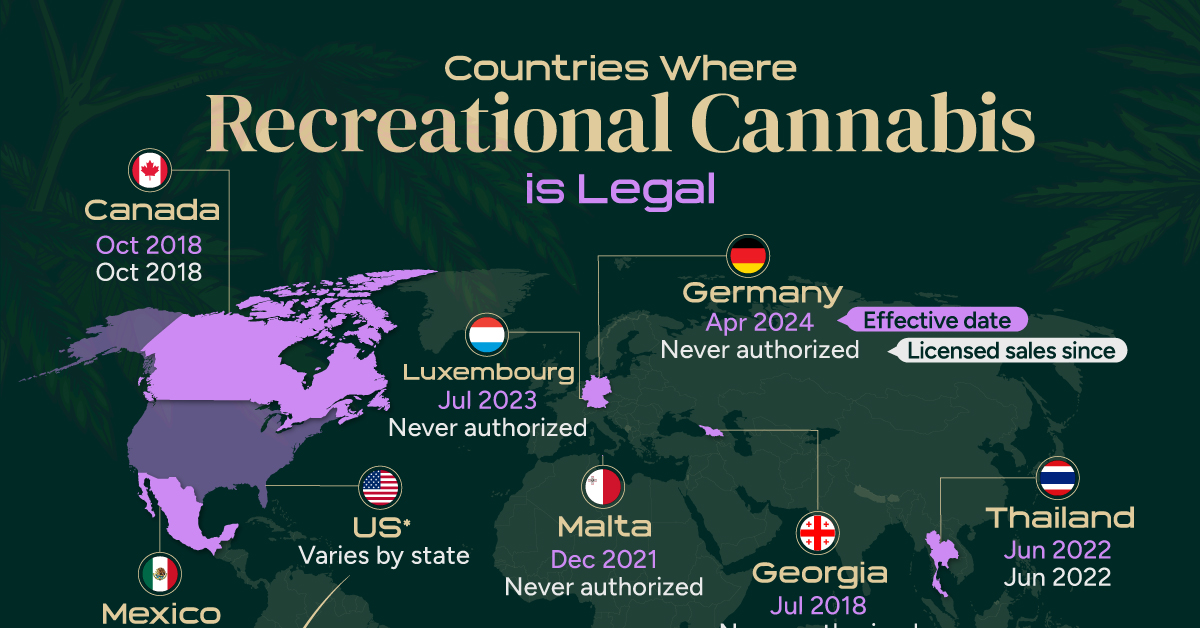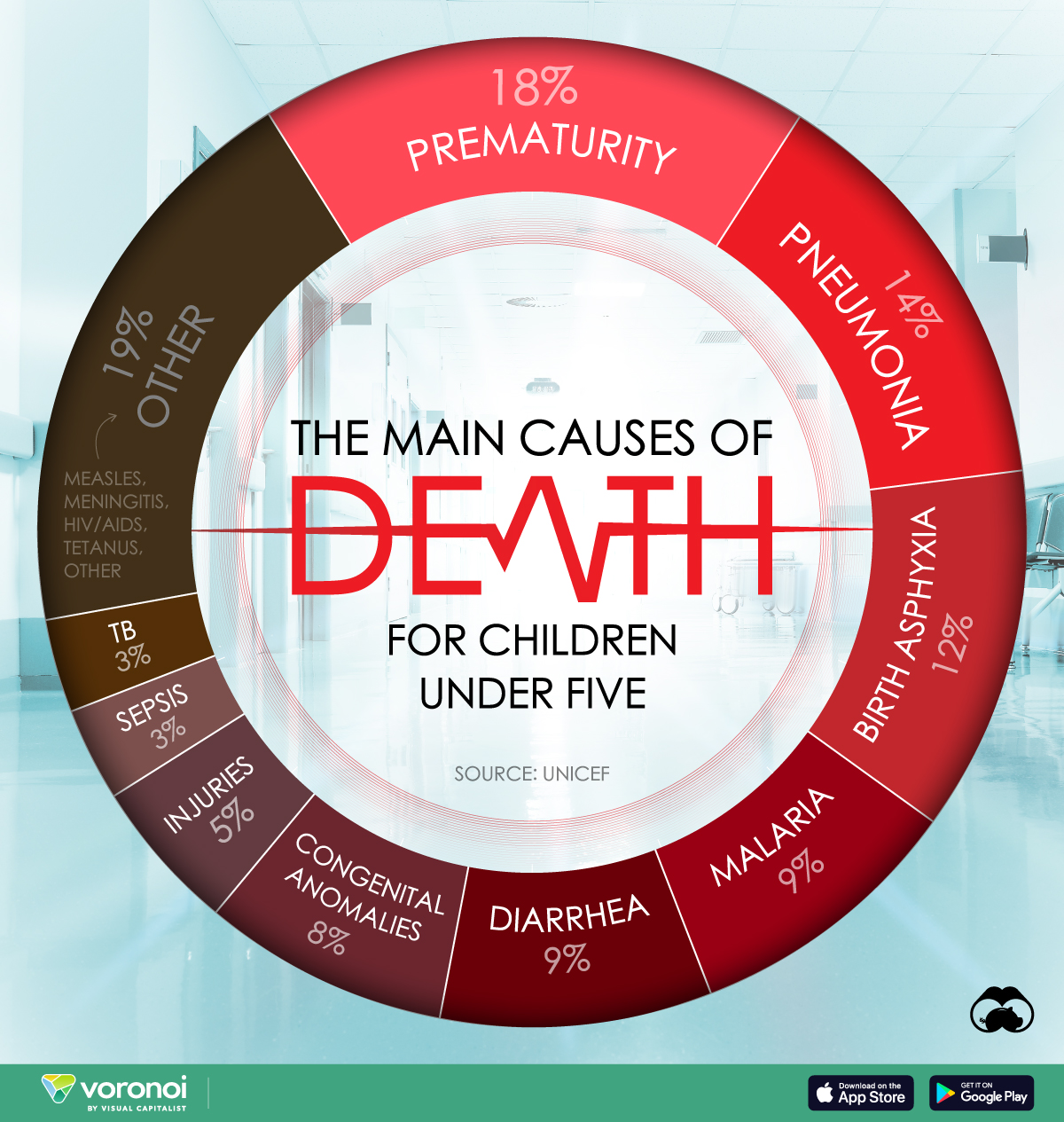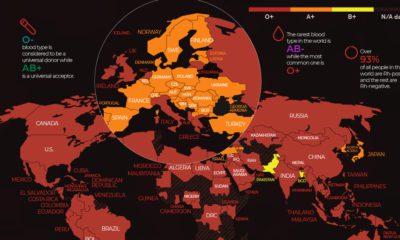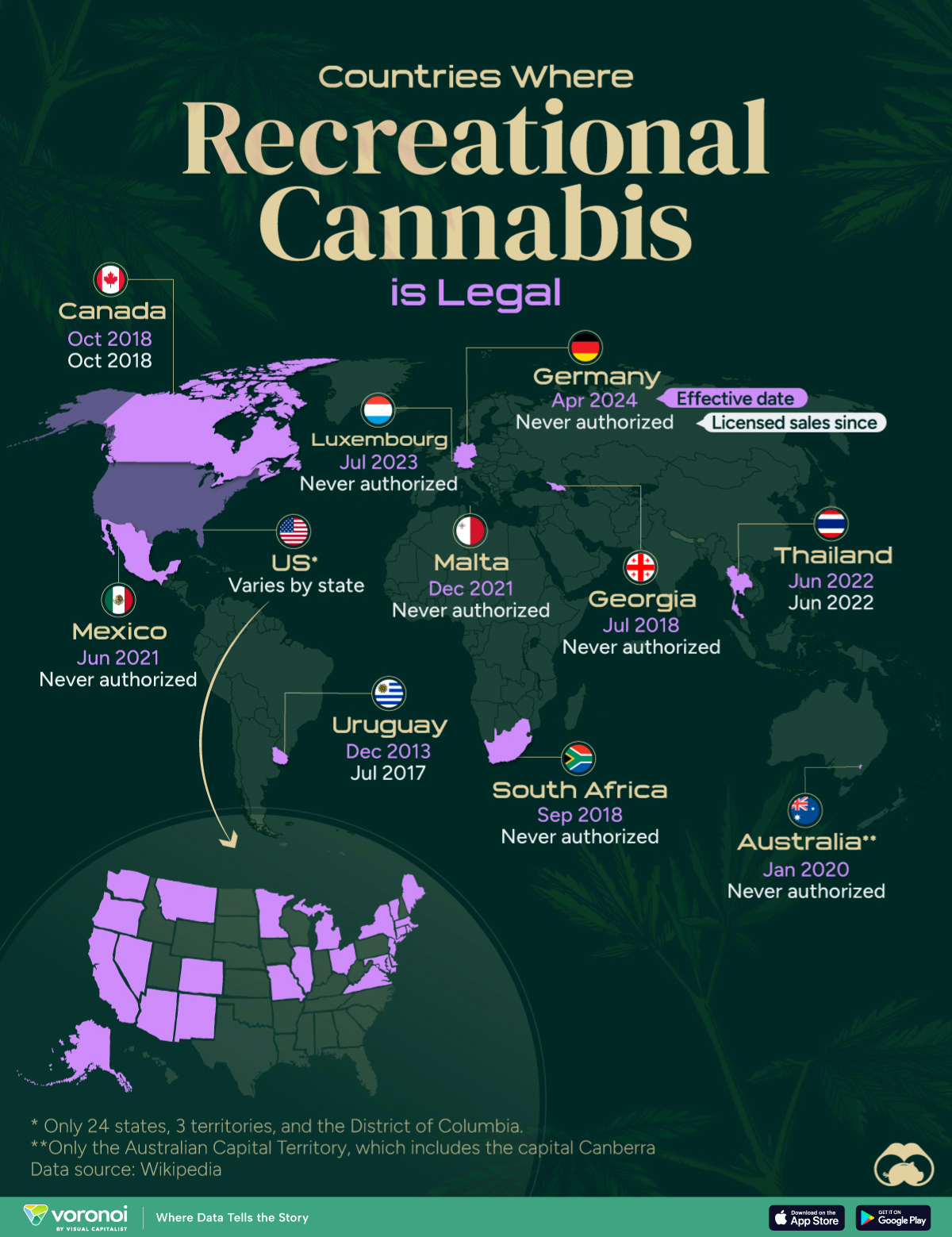Healthcare
What Causes Preventable Child Deaths?
![]() See this visualization first on the Voronoi app.
See this visualization first on the Voronoi app.
What Causes Preventable Child Deaths?
This was originally posted on our Voronoi app. Download the app for free on Apple or Android and discover incredible data-driven charts from a variety of trusted sources.
One of the often-overlooked successes of the modern era is the light-speed innovation in healthcare, easily seen in improvements in life expectancy.
The drop in infant mortality is another example. In 1990, more than 12 million preventable child deaths occurred. Three decades later, that number has more than halved. Nevertheless, despite gains, there are still challenges left to overcome.
We visualize leading causes of death in 2022 for children under the age of five according to a UNICEF report, published March 2024.
Ranked: The Causes of Death for Children Under Five
Globally, 4.9 million children under the age of five died in 2022.
| Rank | Cause | % of Global Under-Five Deaths in 2022 |
|---|---|---|
| 1 | Prematurity | 18% |
| 2 | Pneumonia | 14% |
| 3 | Birth Asphyxia | 12% |
| 4 | Malaria | 9% |
| 5 | Diarrhea | 9% |
| 6 | Congenital Anomalies | 8% |
| 7 | Injuries | 5% |
| 8 | Sepsis | 3% |
| 9 | Tuberculosis | 3% |
| N/A | Other | 19% |
Figures are rounded.
Nearly one-in-five of all deaths occurred because the baby was born too early, before 37 weeks of pregnancy were completed.
However there’s a huge caveat to this particular cause of death.
In low income countries, where health infrastructure is suboptimal, half of the babies born two months early do not survive. For the same preterm babies in high income countries, nearly all survive. This indicates how much neonatal support (access to warmth, breastfeeding, and basic infections care) can reduce infant mortality.
Pneumonia is another significant cause of under-five deaths. It’s an acute respiratory infection, and is extremely contagious: through air, fluids, and contaminated surfaces. Exposure to air pollution significantly increases the risk of developing pneumonia.
However, pneumonia caused by bacteria is also extremely treatable through low-cost antibiotics, and preventable through the pneumococcal (PCV) vaccine.
Put together, preterm births and pneumonia cause nearly one-in-three preventable child deaths.
Cannabis
Mapped: Countries Where Recreational Cannabis is Legal
In total, only nine countries have fully legalized recreational cannabis use.

Countries Where Recreational Cannabis is Legal
This was originally posted on our Voronoi app. Download the app for free on iOS or Android and discover incredible data-driven charts from a variety of trusted sources.
In 2024, Germany became the third European Union country to legalize cannabis for personal use, following Malta and Luxembourg.
Here, we map the countries where recreational cannabis use is allowed as of April 2024, based on data from Wikipedia.
Limited to Few Countries
In total, only nine countries have legalized recreational cannabis use nationwide. However, just a few of them have licensed sales.
| Country | Effective date | Licensed sales since |
|---|---|---|
| 🇺🇾 Uruguay | December 2013 | July 2017 |
| 🇬🇪 Georgia | 30 July 2018 | Never authorized |
| 🇿🇦 South Africa | 18 September 2018 | Never authorized |
| 🇨🇦 Canada | 17 October 2018 | 17 October 2018 |
| 🇲🇽 Mexico | 28 June 2021 | Never authorized |
| 🇲🇹 Malta | 14 December 2021 | Never authorized |
| 🇹🇭 Thailand | 9 June 2022 | 9 June 2022 |
| 🇱🇺 Luxembourg | 21 July 2023 | Never authorized |
| 🇩🇪 Germany | 1 April 2024 | Never authorized |
| 🇺🇸 U.S. | Varies by state | Varies by state |
| 🇦🇺 Australia | Varies by jurisdiction | Never authorized |
At the federal level, cannabis is still considered an illegal substance in the United States. That said, individual states do have the right to determine their laws around cannabis sales and usage. Currently, cannabis is allowed in 24 states, 3 territories, and the District of Columbia.
Interestingly, the oldest legal text concerning cannabis dates back to the 1600s—when the colony of Virginia required every farm to grow and produce hemp.
Since then, cannabis use was fairly widespread until the 1930s when the Marihuana Tax Act was enforced, prohibiting marijuana federally but still technically allowing for medical use.
Today, the U.S. cannabis market is a $30 billion business. By the end of the decade, that number is expected to be anywhere from $58 billion to as much as $72 billion.
Similar to the U.S., Australia does not allow the use at the national level, but cannabis can be used legally in the Australian Capital Territory, which includes the capital Canberra.
-

 Cannabis5 days ago
Cannabis5 days agoMapped: Countries Where Recreational Cannabis is Legal
-

 Healthcare2 weeks ago
Healthcare2 weeks agoLife Expectancy by Region (1950-2050F)
-

 Markets2 weeks ago
Markets2 weeks agoThe Growth of a $1,000 Equity Investment, by Stock Market
-

 Markets2 weeks ago
Markets2 weeks agoMapped: Europe’s GDP Per Capita, by Country
-

 Money1 week ago
Money1 week agoCharted: What Frustrates Americans About the Tax System
-

 Technology1 week ago
Technology1 week agoCountries With the Highest Rates of Crypto Ownership
-

 Mining1 week ago
Mining1 week agoWhere the World’s Aluminum is Smelted, by Country
-

 Personal Finance1 week ago
Personal Finance1 week agoVisualizing the Tax Burden of Every U.S. State







